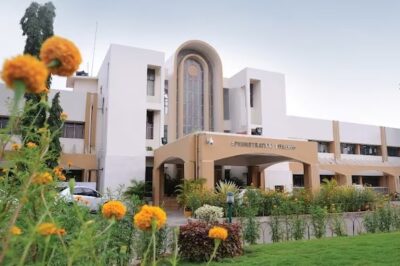
In a significant development concerning environmental preservation and urban development, the Telangana High Court has intervened to halt construction activities on a 400-acre tract in Kancha Gachibowli, adjacent to the Hyderabad Central University (HCU).
Judicial Intervention to Preserve Green Cover
On April 2, 2025, the Telangana High Court issued an interim stay on all development activities in the Kancha Gachibowli area. This decision came after petitions were filed by students and the environmental organization, Vata Foundation, highlighting concerns over potential environmental degradation. The court’s order mandates a cessation of all land-clearing and construction activities until the next hearing scheduled for April 3, 2025.
Government’s Position and Legal Proceedings
Advocate General A. Sudarshan Reddy, representing the Telangana government, defended the state’s actions, stating that the 400 acres were initially allocated to IMG Academy in 2004 but were reclaimed after the company failed to utilize the land as intended. He emphasized that the area is not designated as forest land, pointing to the presence of high-rise buildings and helipads on neighboring university properties as evidence of its non-forest status.
However, the petitioners argue that the land possesses significant ecological value, serving as a crucial green buffer for the region. They contend that the presence of diverse wildlife, including snakes and peacocks, indicates the area’s sensitivity and warrants protective measures.
Supreme Court’s Immediate Intervention
The issue escalated to the Supreme Court, which on April 3, 2025, ordered an immediate halt to all tree-felling and excavation activities in the Kancha Gachibowli forest area. The bench, comprising Justices B.R. Gavai and A.G. Masih, directed the Registrar (Judicial) of the Telangana High Court to conduct an on-site inspection and submit an interim report by 3:30 PM on the same day.
The Supreme Court’s order was prompted by media reports highlighting extensive deforestation activities during the preceding weekend, raising concerns about the impact on local flora and fauna, including species such as peacocks and wild boars. The court noted the urgency of the matter, questioning the rapid commencement of deforestation activities without thorough environmental assessments.
Environmental Significance of the Disputed Land
The contested 400-acre land in Kancha Gachibowli is situated near the University of Hyderabad and is characterized by its rich biodiversity. The area is home to various species of flora and fauna, including mammals, birds, and rare plant species. Notably, the land encompasses three lakes – Peacock Lake, Buffalo Lake, and another unnamed reservoir – that serve as vital catchment areas for the city’s drinking water supply.
Environmental experts and activists argue that the land functions as the “lungs of the city,” playing a crucial role in balancing pollution levels from the surrounding financial district and high-rise developments. They emphasize that the ecological importance of the area extends beyond its current designation, advocating for its recognition as a protected ecological zone.
Public Response and Ongoing Legal Proceedings
The government’s plan to auction the land for IT infrastructure development has faced significant opposition from students, faculty, and environmental activists. Protests have erupted, with demonstrators expressing concerns over potential environmental degradation and the loss of green spaces. The legal battle continues, with the Telangana High Court scheduled to hear further arguments on April 3, 2025.
As the situation develops, stakeholders await the outcomes of judicial reviews and government assessments to determine the future of the Kancha Gachibowli land. The case underscores the complex interplay between urban development and environmental conservation, highlighting the need for balanced and sustainable land-use policies.
This unfolding legal and environmental saga serves as a reminder of the challenges cities face in managing urban expansion while preserving vital ecological resources.









































Leave a Reply